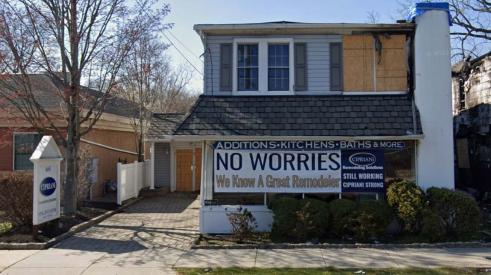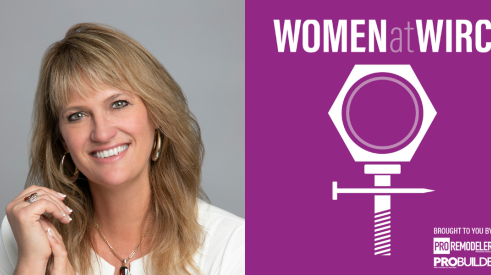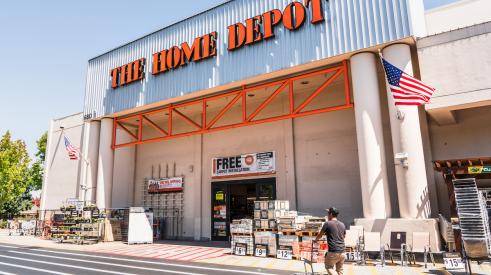|
 |
 |
| With just a bit of the addition's roof visible, the cottage still dominates the street view. Photos courtesy of PJ Builders |
Referrals are important for any remodeler, but for Pete Olson they hold special weight. Why? Because 80 percent of his clients don't live in or anywhere near town, so they rely heavily on any recommendations they can get their hands on.
Olson's company, PJ Builders, remodels and builds in the greater Park City, Utah, area.
A silver mining boomtown in the late 1800s, Park City was reborn as a ski center 100 years later. It hit the big time as a mountain resort destination when it hosted the 2002 Winter Olympics. These days the population swells from less than 10,000 to 25,000 or more during the ski season. To be at the top of the "try this guy" list for seasonal residents planning vacation home projects, Pete Olson has fine-tuned the art of working with absentee clients and of remodeling miners' cottages in historic Old Town Park City.
Pete Smith and his family live in California but have been vacationing in Park City for years. In 2005, they bought a historic tiny miner's cottage just steps from a ski lift. They soon realized that the five-room, 864-square-foot house (432 square-foot 1900s original with a 432 square-foot 1950s extension) was too small. As things go in Park City, Smith asked his real-estate agent to recommend some local architects. She directed him to Jonathan DeGray, who's designed many renovations and knows the ropes of remodeling in Old Town. Smith then asked DeGray to recommend contractors.
Having worked with DeGray on several projects, PJ Builders made the list. One of the other two recommended contractors fell out of contention quickly, in part because he couldn't start the job for a year, and in part because he was uncomfortable communicating by computer. "I e-mailed my specs to the three companies," Smith says. "Two responded in the time I requested." Of those two, one was much bigger than PJ Builders and had just finished a similar job down the street. But Smith leaned toward Olson. "His estimate was considerably lower and he was much faster to respond," says Smith. "I liked Pete's enthusiasm. And though he hadn't done anything this size, I'd seen some of his work and was impressed."
 |
| Olson gutted and stabilized the cottage for its two moves - off the lot to a neighboring yard, then back onto newly poured footings. |
"I was really interested in this job, and the challenges involved," Olson says. Chief among those challenges was that the house had to be craned off the lot. Like most Park City miner's cottages, the 1900s house had been built quickly as temporary housing, and had no foundation. It sat on 6 by 6 posts in the dirt. A neighbor planned to remodel his cottage too, so Olson and he split the crane costs and minimized street closings for crane operation. Another neighbor had a big, overgrown backyard. In exchange for clearing and re-grading the yard, Olson arranged to park the cottage there while excavating and pouring the foundation on the permanent site.
Once he razed the 1950s add-on, Olson concentrated on securing the old house for its move. The cottage had thin walls, no insulation and, to everyone's surprise, no framing. The siding was nailed to 1 by 12 vertical strips. The place "was built like a shipping crate," says DeGray. Olson gutted the house to lighten the load before moving it, then reinforced the structure. He needed glulam beams for the remodel and saved money by giving them a dual use. He ordered them two feet longer than required for final installation, inserted them in the house, cut four holes in the roof, and attached cables to the beams. The crane grabbed those cables and lifted the house. "It was like the Wizard of Oz," Olson says. Later he cut the beams down.
 |
 |
| Olson converted the cottage to an open living-dining area and replaced the 1950s addition with a two-story, four-bedroom structure. The open "mountain contemporary" interior features a corner fireplace with rustic stone surround. |
DeGray repositioned the house farther forward on the lot than it had been, making room for a large rear addition and lining up the front with other cottages on the street. After the crane deposited the cottage on its footings, Olson faced the challenge of framing it. The historic exterior had to be preserved. That meant framing had to be built within the existing shell. Olson did it by making exterior walls inside the house, pushing them against the siding, and attaching them.
Though the addition behind the cottage is a large, two-story structure — 1,843 square feet, including a 300-square-foot garage — it is barely visible from the street. DeGray designed a low-pitch roof that hides behind the perky 12/12 roof of the cottage. The city required the cottage's lap siding to be patched where necessary rather than replaced. To blend the addition with the cottage, DeGray specified matching siding and used windows in a proportion and number that harmonize with Park City's old buildings.
Inside, the remodeled cottage contains a cozy living-dining area. The addition provides four bedrooms and bathrooms, plus a second-floor sitting area where Smith's two teenagers and their friends can gather. The kitchen links old and new structures.
Because of the lot characteristics, the design could be reviewed by the city planning staff rather than the board. It sailed through with only minor modifications. Nevertheless, by the time design approval came through and the framing was completed, winter had arrived. And an especially harsh winter it was. "We had several subzero days, and it was below 20 the other days," recalls Olson. Before starting work each day, his crews had to torch the ice and shovel snow off the house. "People work slower when it's cold," he adds. The extreme weather added labor time and cost to the project.
 |
| The tiny, 1900s miner's cottage consisted of three rooms; a 1950s addition provided elbow room and indoor plumbing. |
Added Value
Shoveling the driveway and walkway of the remodeled house should never be necessary though. That's because Olson installed radiant heating under the concrete. Radiant heat is the sole heat source inside the house too. As year-round residents of Park City, both Olson and DeGray advised Smith not to invest in supplementary forced air heating (radiant heat is enough, they said) or air conditioning (not necessary). "I'm really pleased with the radiant heat," Smith says.
Access to such tips proved to be one of the bonuses of working with PJ Builders. Another was resourceful communication. Smith would visit the project every two or three months, and between visits, he and Olson exchanged e-mails regularly. Olson even held a virtual walk-through, putting Smith on the phone from California as Olson and the electrician went around the house to choose locations for lighting and outlets. As the remodel took shape, Office Manager Stacy Kueser transmitted digital photos of the house to Smith. "It was a great way for me to keep an eye on progress," he says. "Use of communications technology was essential," observes Smith. "I can't imagine doing a project like this with quill and paper."
Kueser helps absentee clients in other ways as well. She found a leasing agent for Smith, to rent the house when the family's not using it; managed the house keys; set up house cleaners; and went over to the property to let in the furniture deliverymen. "She did a great job," says Smith.
The only big mistake on the project, says Smith, was his own. "I gave the contractors very limited specs. I missed a lot" — hence the big differential between estimate and final cost. "The lesson I've learned is to make sure all items are in the specs, and that the specs match the bids," says Smith.
As for the completed project, "Everything seems great," Smith says. He's not the only one who thinks so. Park City did too: The house won the 2007 Park City Historic Home Preservation Award.
Project Timeline
| 2006 | Stage of Project |
| March 29 | Initial phone contact |
| May 2 | Meeting at site |
| June 22 | Contract signed |
| June 29 | Begin demo of existing house interior |
| Aug. 2 | Complete securing of house for move, crane from site |
| Aug. 29–30 | Pour footings |
| Sept. 11 | Pour foundation |
| Oct. 20 | Complete main floor framing |
| Nov. 16 | Crane house to new foundation |
| Nov. 17 | Begin framing old house and addition |
| 2007 | |
| Feb. 15 | Begin installing radiant and snow-melting systems |
| Feb. 19 | Begin window installation |
| March 5 | Complete framing, begin siding |
| March 28 | Pass four-way inspection |
| April 4 | Add insulation |
| May 15 | Begin tile installation |
| June 22 | Begin wood floor installation |
| Aug. 31 | Finish interior painting |
| Sept. 14 | Install appliances |
| Oct. 9 | Complete interior finish and trim |
| Oct. 31 | Project complete for homeowner walk-through |
| Nov. 7 | City inspection |
| Nov. 30 | Wood fence finished |
| Payments | |
| Clients billed on the 15th and 30th of every month |
|
Remodeling this mountain resort vacation home called for preservation smarts, creative problem solving and a knack for working with out-of-town clients
Add new comment
Related Stories
4 Steps to Prep Your Business for Contraction
How a remodeling company plans ahead for the worst of times (and the best of times)
Creating a Company Fire Drill: How to Prepare for the Worst
A disastrous fire could have been a lot worse if the business wasn’t prepared for the unexpected
The Fundamentals of Growing Profitably
On this episode of Women at WIRC podcast, Nip Tuck Remodeling Owner April Bettinger shares how she plans for her company's profitable growth
3 Things to Add to Your Construction Contract—From a Lawyer
Did you know you can add these three elements to your contracts?
Study Finds Remodelers’ Net Profits Declined
How far did net profits decline and what's influencing the drop?
The Home Depot Bets on Pros Amid Predictions of Flat Sales Growth
For the first time since 2019, The Home Depot’s revenue fell short of Wall Street’s predictions amid a general softening in the home improvement market
Indicators of a Softening Market and How to Prepare
Market conditions could be changing, but don't panic. Richardson shares ways to stay on top of market conditions and how to prepare for any potential softening down the road.
Grow Your Business Through Collaboration with Remodeling Peers
Remodeling Mastery Forums offers a unique business opportuniy for remodelers












